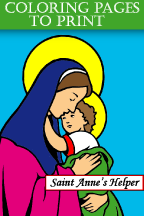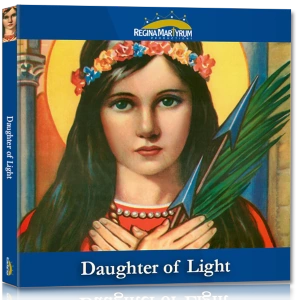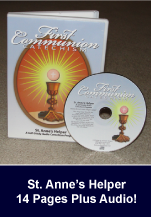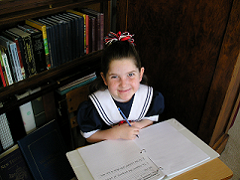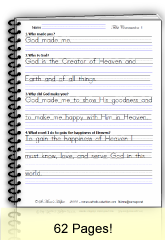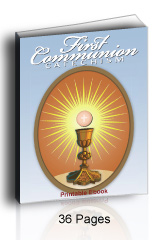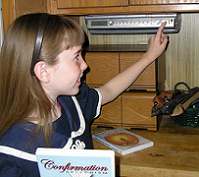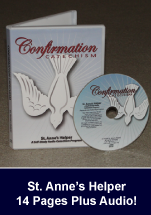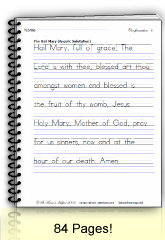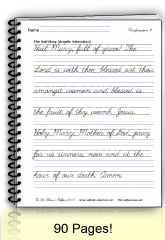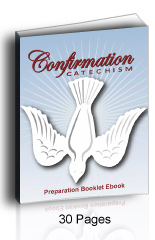- Home
- Seven Catholic Sacraments
- Catholic Missal
A Catholic Missal Uses
The Douay-Rheims Bible Translation
Comparing Catholic Missals
Which traditional Catholic Missal is the best Latin Mass Missal?
- New Marian? (Angelus, Baronius, Loreto, etc.)
- Lasance?
- St. Andrew?
- 1962?
These four all generally have used the Douay-Rheims Bible wherever they quote the Bible. Check yours.
A good one will use the Douay-Rheims Bible whether it is a Sunday Missal or a Daily Missal.
I've made some huge updates on this page so, if you've been here previously, you may find more info about different Missals.
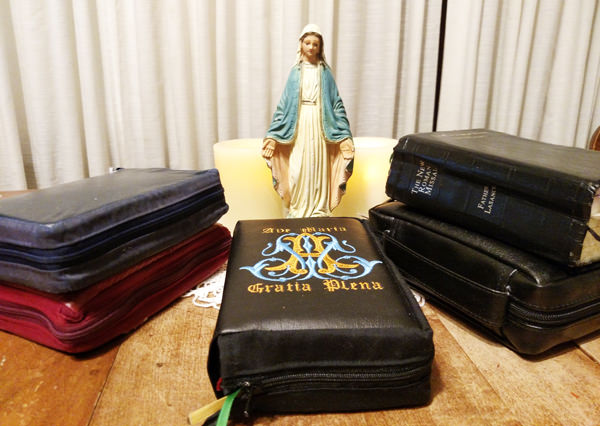 A Latin Mass Catholic Missal makes it easier to follow the Mass prayers.
A Latin Mass Catholic Missal makes it easier to follow the Mass prayers.Old Missal, New Bible?!
Think about it. What sense does it make to use an old Missal with new Bible quotes?
None.
Being the first Biblical "thought for the day" book, the Missal has scripture readings for every day through the year.
You would think that the words and meanings would remain the same, yet most people are surprised to learn that there are many different books called Bibles.
Your Missal may well be the dearest book you will ever own if it has the Douay-Rheims translation, the traditional prayers, and a nice format. Mine is.
In general, the Missal is the most used book at our house for sure.
See these main sections below for Catholic ideas for choosing your own Missal:
- Traditional Missals - Children's books, New Marian, Lasance, Angelus, Baronius.
- Out of print Missals - New Marian, St. Andrew (with Douay)
- How to choose a good Missal - Selecting a Daily Missal. Which one is best?
- Matters of trust
- Latin Missal video
- Questions and Answers
- Readers' comments
Which Missal To Use? 1962 or Earlier?
It depends on which Mass you attend. (I know. That's an awful statement about "the" Mass).
The New Marian Missal, enjoys the most popular support and has the most versions in print. Both the Baronius Press version and the Angelus Press versions of the 1962 Catholic Missal use the New Marian.
All three use Douay-Rheims Bible quotes for the Sunday and Daily Propers. You will be able to follow along quite well at the Fraternal Society of Saint Pius X (FSSPX), Fraternal Society of Saint Peter (FSSP), and other traditional Latin Masses with these books.
Where it gets tricky:
- There are some SSPX and FSSP priests that use the earlier Missals.
- Pope Benedict and Pope Francis have given some congregations explicit permission to use old Missals.
- Also, some orders like the traditional Benedictines have been able to keep their Missal from before 1962.
What's the main difference between traditional Missals?
The main difference with the older Missals is that, as early as 1948, Bugnini was busy removing many readings from the Proper of the Day and many ceremonies from the newer and newer Missals.
If you own an older Missal, you'll have the right prayers; but you'll have to skip through some - especially during Holy Week because Bugnini and his buddies were busy removing as many prayers as they could as quickly as they could.
So, to a point, the older the Missal the better. At least you have more prayers than fewer.
So many changes had already been made by the mid 1950s that, in effect, the "official" 1962 is not much different from the 1956 or 1958 versions.
For twenty years an old Missal (1953?) was all that I had had. It had been a gift from my parents, thank God; so I simply learned to navigate through the extra prayers when a priest was using a newer Missal. If I was at a sung Mass I had time to read the extra prayers, which is wonderful!
Otherwise, it's fairly simple to skip to wherever the priest is reading if you pay attention to the first words of the next Latin prayer or if you look for proper nouns with their revealing capital letters.
Now that new editions are available you have more choice.
The old New Marian, Lasance, and St. Andrew Missals were wonderful, and the reprints have near zero changes from the versions reprinted from the 1940s and 1950s. The pictures, or images, are lovely and instructive.
The Lasance is particularly excellent for boys who want to be altar boys because the pictures in the Ordinary of the Mass show the main action of the server at the correct moments.
Still wondering which Missal to use?
Ask your priest which Missal he uses or recommends so that you can make your decision better. If you go to different Masses due to travel, etc., you might want an older Missal so you would have all, or more, of the prayers.
In this case you would also not have some of the 1962 (or 1970?!) feast days - I'm not sure of all of which feasts these would have been, but I think that there are a few like Mother Cabrini's feast day which before 1970 was on the date she died or entered Heaven, December 22. The 1970 calendar moved the date to November 13. I have no idea why. Nor do I know why a "1962" book would use an element from the 1970 Liturgical Calendar.
The main time the different calendars would be a challenge is for daily Masses, or the temporal cycle with its feast days as with St. Frances Cabrini's feast day.
If you know the old date you're set. If you don't and if there is no Mass proper, use one of the Common Propers to have most of the prayers. This way, if you already have an older book, you won't need to buy a new version. (It would be a huge study to keep track of the date changes throughout these many years.)
The specifically "1962" Missals with the Douay scripture quotes are the Baronius and the Angelus versions. I share some comparisons between these Missals below.
Buy A Traditional Catholic Missal - Check For The Douay Translation
Disclosure: I show products that I think will help you. If you use my links, I may earn ad commissions at no extra cost to you. As an Amazon Associate I earn from qualifying purchases.
As an Amazon Associate I earn from qualifying purchases.
1. Uses the 1958 calendar, virtually the same as the 1962 Catholic Missal.
2. 1945 calendar with additions. Wonderful pictures.
3. Uses some 1970 dates (Cabrini), maintains priest and sacrifice in rubrics.
4. Uses the 1962 dates, changed priest to celebrant and sacrifice to celebrate.
1. Latin-English Catholic Missals In Publication
You'll want to find a Catholic Missal that has a good translation of the Ordinary which is the part often found in the center of a Catholic Missal that is said for every Mass, both Sundays and weekdays.
A clue to a good Ordinary translation is the Judica me, the first prayer. The Douay uses:
- "Judge me, O God, and distinguish my cause from a nation that is not holy".
If the text reads otherwise, try to source whence it came. Hint: It's likely to be a 1940s Confraternity of Christian Doctrine (CCD) or New American Bible (NAB) translation.
1.A. Why Does The Latin Translation Matter?
The Catholic Mass encompasses all the basic Catholic beliefs. "Lex orandi, Lex credendi." We believe what we pray, so it is eternally important to buy a Missal that teaches the Catholic Faith using Catholic terms.
The Bible is a huge source of what Catholics believe. Beware versions that use unisex language and paraphrases like the CCD and NAB.
There are so many old Missals that it is super hard to compare them all, yet be encouraged that there are easy clues to the most important parts.
Even in different editions of the same version there are many un-documented changes so there's no way to keep track of all of them. The best place to start is to determine which Bible was used and if the Ordinary prayers in the middle of the book are good.
Now to add to this difficulty. Try helping different children with different Missals! It's kind of tricky. . . . Here are some suggestions:
1.B. Catholic Missal For Children - My Mass Book
1990s My Mass Book By Neumann Press
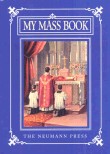 My Mass Book Child's Missal
My Mass Book Child's MissalFirst, let's talk about finding a child's Catholic Missal. There are many and they often have a child's version of the Ordinary.
What I like about My Mass Book as published by Neumann Press is that the one published in the 1990s had the exact same English prayers as the adult Missal.
- It also had excellent pictures that showed where the priest is on the altar.
- It explained some prayers in the Mass nicely.
- Gave the usual prayers for Eucharistic devotion.
- And even the prayers for other Sacraments like
- The Baptism ceremony.
You'll love this book as it skips the fluff in other books. I hope that current or future editions remain the same.
My Mass Book For Altar Boys
My Mass Book was an excellent book for boys hoping to become altar servers because they could see what the priest and altar boys are doing in the pictures. The pictures help them see and follow the Mass.
During Mass the children often cannot see over adults to see what is happening, yet when they hear the bell they could go to the picture of the server ringing the bell.
Also, the pictures are fairly well spaced for matching the speed at which a priest goes through a Low Mass.
As of this update, the My Mass Book is not in publication; yet you can check to see if it is back in publication or if there's a child's Missal or prayer book that you would like at Amazon.
Size of My Mass Book And Other Children's Missals
One drawback is that My Mass Book can be a bit long lengthwise when shorter children are kneeling.
Why? The book hits the pew in front of them. The better text and great drawings were worth it for our family. It is great for a little child who knows not to tear a page, yet is free to sit for part of the Mass.
You may like giving your children smaller books till the time when they can handle a larger "real" Missal and they are better ready to read the text.
The Fr. Lasance Missal below is an excellent Catholic book for older children as it has similar and wonderful pictures of the Mass in progress.
It is best for older children who can handle a nearly Bible sized book. See its description in 1.D. below.
Jesus, Make Me Worthy Mass Book
Jesus, Make Me Worthy is a wonderful and small book for children to take to Mass.
It has
- Beautiful color pictures,
- A Mass section,
- Many Catholic prayers for children,
- Manner of Serving At Mass for altar boys,
- Notes on the Seven Sacraments,
- Litanies, Benediction in Latin,
- Stations of the Cross
- And catechism aids like the Ten Commandments and the Beatitudes.
One thing I love about the Mass pictures is that behind the priest are images of Jesus doing the same as the priest is doing. This makes a great association for kids. Be sure to notice and to show your children.
It's size is perfect for kneeling children who are shorter than the pew in front of them.
It's also light weight and well bound which makes it great for school or every day use.
1.C. The New Marian Daily Missal
My first experience using a Missal was with a New Marian Daily Missal.
It remains my favorite, because it uses the Douay translation, has beautiful prayers, and is easy to read - especially for sung Masses or dialog Masses. The Gloria and Credo are easy to "answer" in the New Marian and Baronius as the phrases are divided in the correct places.
The St. Andrew and Lasance do not have this format because it is new for the Catholic laity to sing or dialog Mass responses.
When I first read the opening prayer, "Judge me, O God, and distinguish my cause from the nation that is not holy: deliver me from the unjust and deceitful man." I was in love with the Mass. My heart rejoiced, "This is beautiful!"
For years it was the line I used to judge whether a Missal was good or not. Some newer versions' text reads like a spoiled brat wrote the paraphrase, "Do me justice...."
I find that the New Marian Missal has as good or better a layout than the Lasance, is much easier to hold, and does not have some of the changes that the Angelus Press version has.
Catholic Free Shipping and Loreto Publications have been alternative sources for the New Marian, too. Just recently in 2019 I was able to buy a nearly unused copy for half the price of a new Missal. Keep searching! :-)
Other features of the New Marian are:
- The Douay-Rheims version of both the Epistles and Gospels, etc.
- Lovely prayers, especially the Prayer to Our Lady of Perpetual Help, page 1420.
- Beautiful woodcut pictures for the main holy days and feast days.
I have used all of the above Missals and treasure the New Marian Missal most. The oldest one we own is an early 1950s version. I would love to have the original 1947 New Marian Missal from before Bugnini's 1948 changes. I hope these notes help you to find one.
All of the Juergens versions (New Marian, Baronius, Angelus), being New Marian Missals, have “the prayers at the end of the Mass” and I think they all have them in both Latin and English.
So do the Fr. Lasance New Roman Missals and the St. Andrew Missals, although the Before and After Communion Prayers are not so easy to find as in the New Marian.
The New Marian and Baronius have beautiful Before Communion Prayers right before the various Prefaces immediately and conveniently before the Ordinary of the Mass. The After Communion Prayers are immediately and again conveniently after the Last Gospel and the Leonine Prayers after Mass.
There are many reprints and publications of The New Marian Missal, so shop around and keep the observations from this page in mind.
1.D. Fr. Lasance New Roman Missal For Catholics
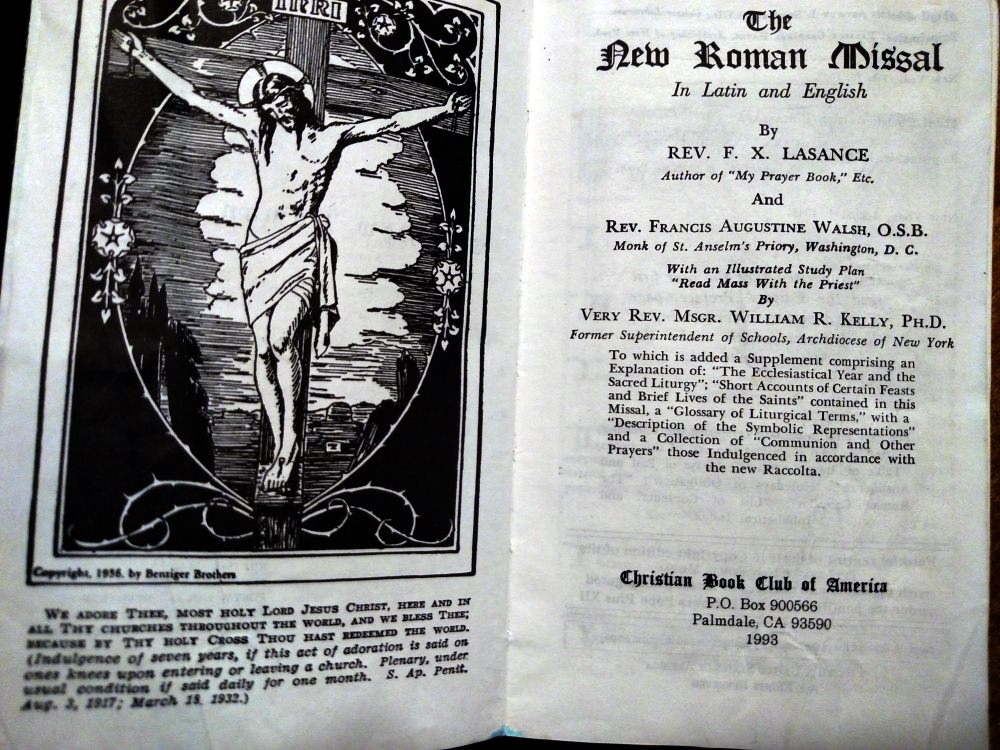 1945 Fr. Lasance, The New Roman Missal For Catholics Title Pages
1945 Fr. Lasance, The New Roman Missal For Catholics Title Pages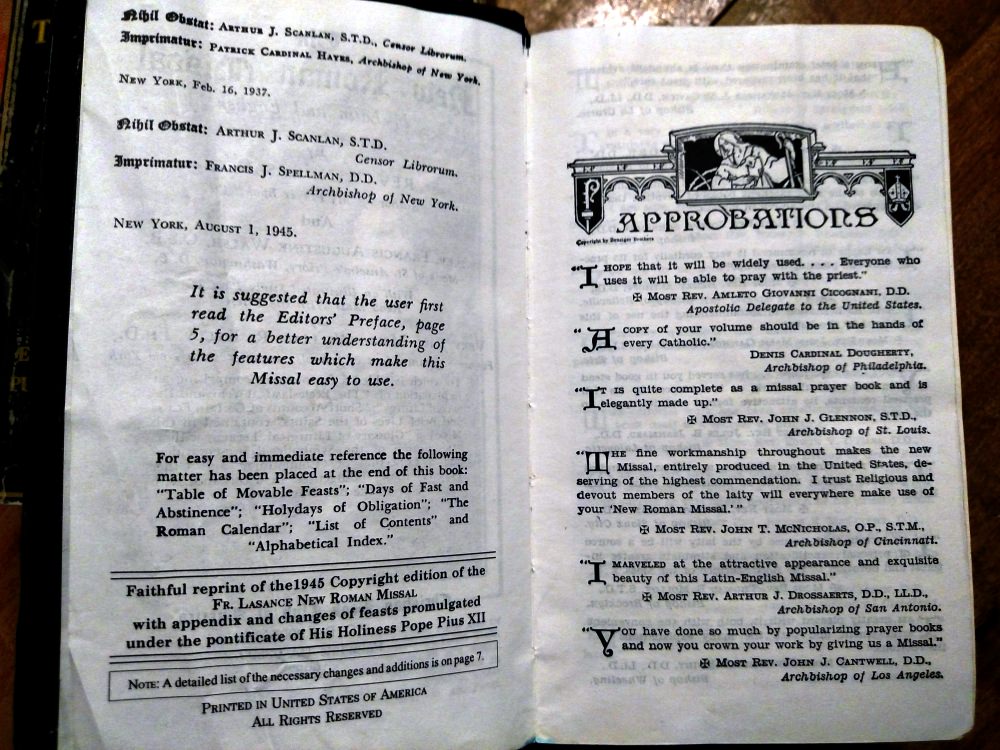 The New Roman Missal, Fr. Lasance Imprimatur Francis Cardinal Spellman
The New Roman Missal, Fr. Lasance Imprimatur Francis Cardinal SpellmanThe New Roman Missal by Fr. Lasance that I own is a reprint of a 1945 Catholic Missal by Fr. Francis Xavier Lasance and has wonderful prayers in the back. Some of my favorite features are that it uses:
- The Douay-Rheims version of both the Epistles and Gospels, etc.
- Latin and English for the Epistles and Gospels.
- Complete Propers so you do not have to flip back and forth in the book.
- Stories of the saints in the back organized by calendar date.
- The complete Angel of God prayer.
- Lovely versions of the prayers.
- Clear pictures of the priest's movements at Mass. Great for altar boys.
- Beautiful woodcut pictures for the main holy days and feast days.
A major consideration, though, is how heavy the book is. It is also so large that it can be hard for small children and oldsters to handle. For those of us in between, it is an excellent choice in spite of being a bit awkward.
You can buy the Lasance Missal at Amazon.
Refuge of Sinners publishing has a version, too.
Winter 2019: A reader was kind to write to let me know that Amazon was out of Lasance Missals. I was glad she wrote. A very popular blogger (Dr. Taylor Marshall) promoted it recently which is possibly why there's been a rush of people buying the Lasance Missal.
I've spent quite a bit of time searching the internet and am finding that it is sold out in over five regular places outside Amazon and Ebay (OLVS, St. Bonaventure, El Camino Real, and others).
I am seeing that the publisher expects to publish it again soon, so I think you'll be able to get the Lasance soon.
- The New Roman Missal by Fr. Lasance is now out of stock and is being reprinted by the publisher. They expect to have it completed in early February.
Spring 2019: Yea! It's back in publication.
1.E. Baronius Catholic Missal
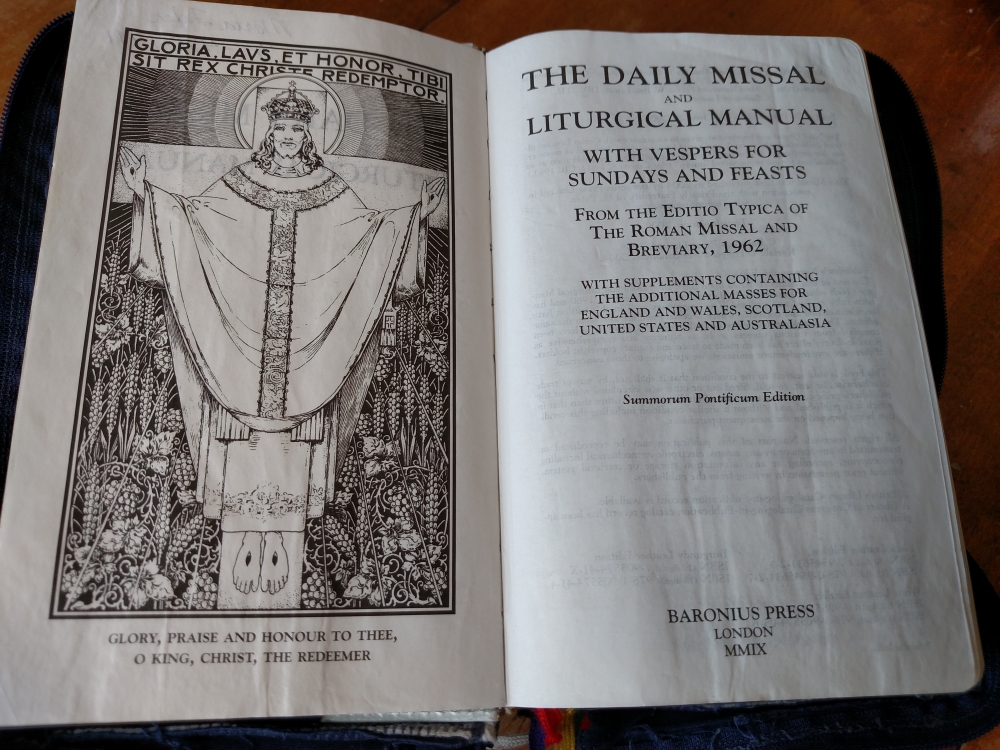 Baronius Press The Daily Missal And Liturgical Manual Title Page
Baronius Press The Daily Missal And Liturgical Manual Title Page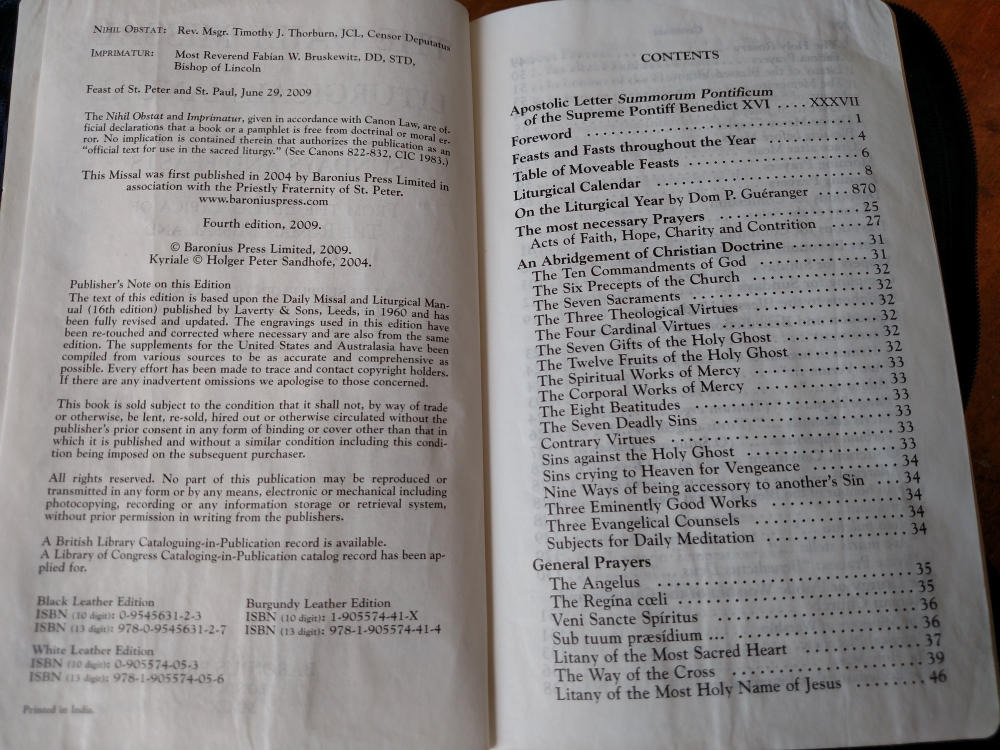 The Baronius Press Daily Missal; Fabian W. Bruskewitz, Imprimatur
The Baronius Press Daily Missal; Fabian W. Bruskewitz, ImprimaturThe Baronius Press Catholic Missal uses a similar text as above. It is based on the New Marian Missal by Sylvester Juergens, S. M.
Baronius newly added the Kyriale in the back as in times past the congregation had not joined in singing the Liturgical hymns until the days of the Dialog Mass in the 1940s.
- Douay Epistles, Gospels, etc.
- Music to the Gregorian Kyriale in the back.
- Instructional notes before the readings.
- Wood cut pictures for the main feast days.
- Notes from the Imitation of Christ at the end of most Propers.
- Some of the dates are from the 1970 calendar (Cabrini November 13).
One thing you'll really like is the soft thin ribbons as they are not so likely to cut your pages as quickly as the thicker ribbons of most newly published Missals - especially if you use a Missal cover that zips tightly.
You can buy the Baronius Missal at Amazon.
What's nice for gifts is that Baronius offers both black and white Missals. The white is especially nice for girls and as First Communion, Confirmation, and wedding gifts.
1.F. Angelus 1962 Catholic Daily Missal
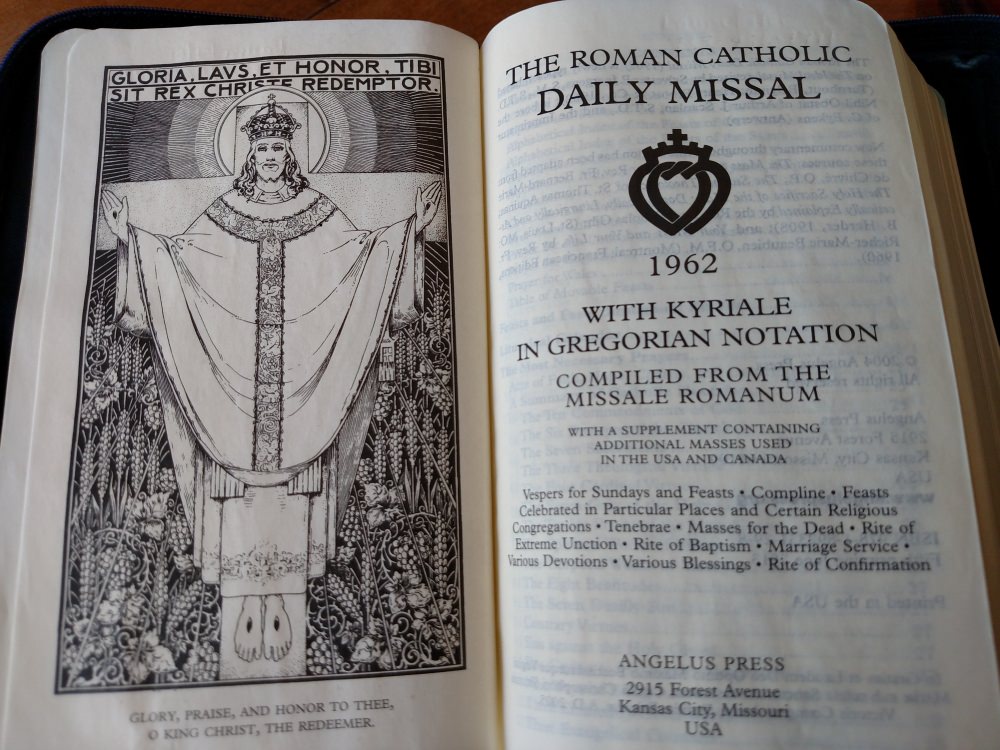 1962 Missal Roman Catholic Daily Missal with Kyriale in Gregorian Notation, Angelus Press.
1962 Missal Roman Catholic Daily Missal with Kyriale in Gregorian Notation, Angelus Press.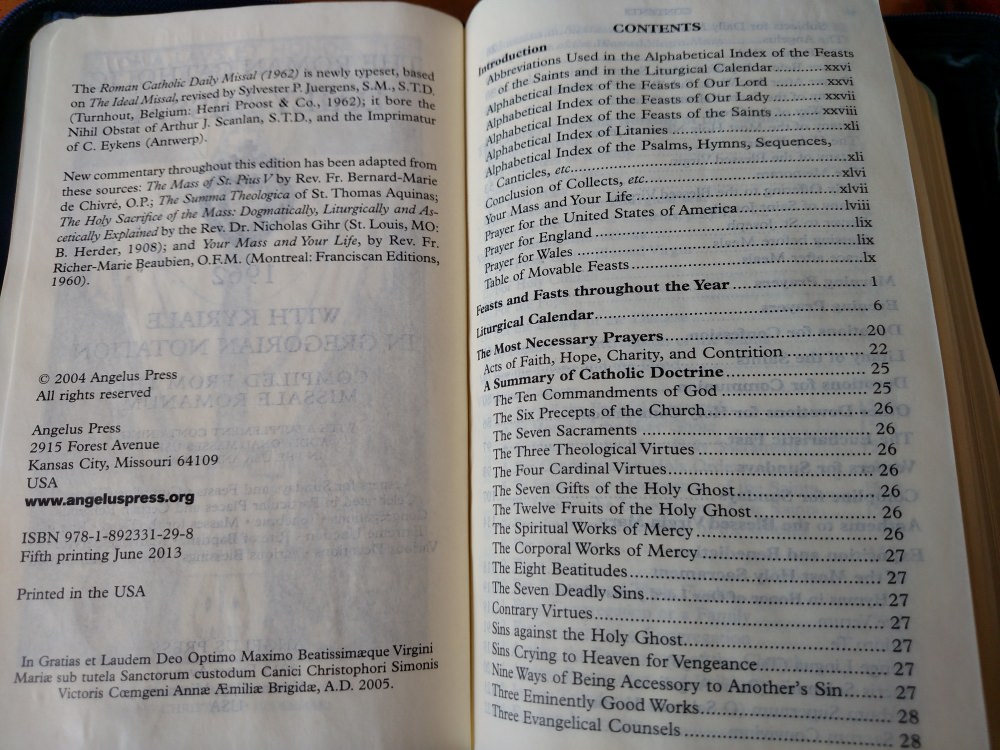 1962 Missal - The Roman Catholic Daily Missal with Kyriale in Gregorian Notation, Angelus Press, Imprimatur.
1962 Missal - The Roman Catholic Daily Missal with Kyriale in Gregorian Notation, Angelus Press, Imprimatur.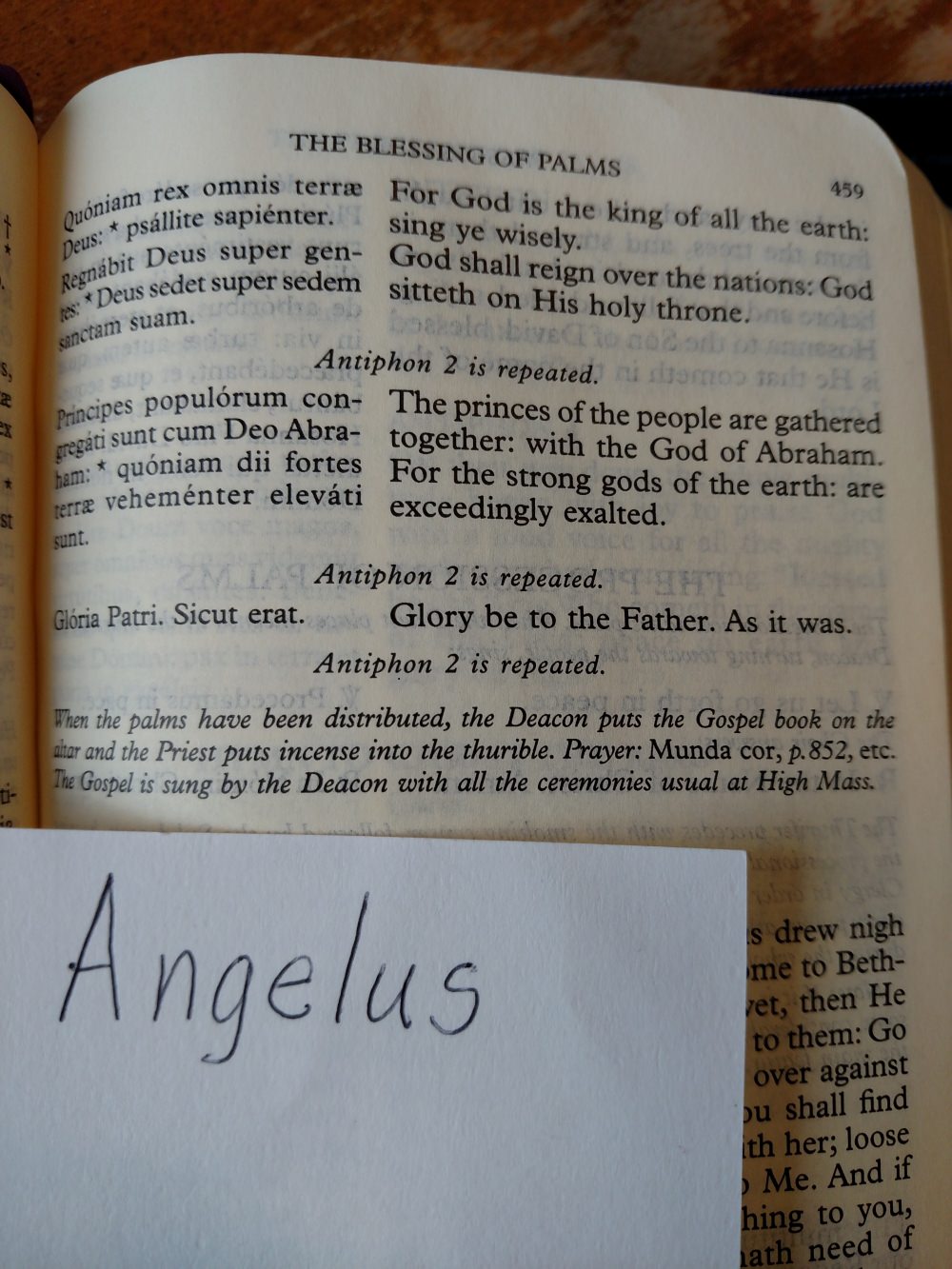 1962 Missal - The Roman Catholic Daily Missal, Palm Sunday Blessing
1962 Missal - The Roman Catholic Daily Missal, Palm Sunday BlessingAngelus Press' Catholic Missal also uses what used to be in the 1940s and 50s The New Marian Missal by Sylvester Juergens, S. M.
Again, like the Baronius, Angelus Press added the Kyriale to the back pages and is very similar to the Baronius (above).
- Douay Epistles, Gospels, etc.
- Instructional notes before the readings.
- Kyriale included.
- Beautiful wood cut style pictures for the main feast days.
- Notes from the Imitation of Christ at the end of most Propers.
- Some of the dates are from the 1970 calendar, yet added in a separate section behind the Propers of the Saints.
In comparison, I think that the current publication has a nice binding that makes it easy to handle at Mass.
I would prefer that they would have put the English translation on the outside because it is harder to read down in the spline of the book. Perhaps it is designed for priests and religious who may appreciate the Latin being easier to read.
The same goes for the Ordinary. They could have put the commentary in the center leaving the prayers easier to read and to pray.
More importantly, there are surprising changes as in the rubrical notes in the first pages of the Mass and other places as compared to the 1953 Juergens version (see below):
- The Angelus version removed the term "sacrifice" and replaced it with the term "celebrate" or "celebration". "Priest" was replaced by "celebrant".
- The Creed in the Angelus version has several changes from the New Marian or the Lasance: "of one substance with the Father" instead of "consubstantial with the Father"; "became flesh" instead of "BECAME INCARNATE"; "And on the third day" instead of "and the third day"; "He will come" instead of "He shall come"; "and of His kingdom there will be no end" instead of "of whose kingdom there shall be no end"; "I believe in the Holy Ghost" instead of "And in the Holy Ghost"; "Who proceeds from" instead of "proceeding from"; "Who spoke through the prophets" instead of "who spoke by the prophets"; "baptism for the forgiveness of sins" instead of "baptism for the remission of sins"; "I await" instead of "I expect" or "I look for".
- "Accept" is changed to "Receive" at the Offertory.
- In the concluding doxology "by Him" is changed to "through Him"; yet it retains "by Him" in the Creed and in the Last Gospel - twice; "through him" references St. John.
Anyway, these are just some things to consider if you buy the Angelus 1962 Catholic Missal at Amazon.
1.G. Missal Covers
You'll want to protect your investment in your Catholic Missal. How?
The Sisters who taught our children recommended that we use Missal covers on the children's Missals and we are so glad we followed their advice. Covers help protect from water damage and breakage.
Hint: Be sure to give the ladies the exact measurements of your particular Missal, as the Missal companies change sizes from year to year and different publishers' Missal versions are sized differently.
We are so glad we listened to the Sisters because our Missals are lasting through years of sometimes daily use.
Another benefit is that differently colored covers help each of us find our own as we get ready for Mass. Here are my favorites:
- Zippered Bible and Missal covers - Custom designed for your Bible, Liber, Missal, child's Missal, or any other book you treasure.
- Genuine leather Missal covers - Shipped from England. You'll receive the VAT tax discount and can buy lovely rosary cases and ribbon markers. I love their best selling leather pocket oratories!
2. Old Catholic Missals - Oldies, But Goodies
If you find these physically old Catholic Missals online, or at bookstores, thrift shops, and yard sales; you'll be glad to know that they have the Douay Bible references, too.
They also have wonderful pictures, timely quotes, and descriptions of the Mass ceremonies.
These are getting harder to find every day, but you might be able to find them at a more discounted price than before the publishers began publishing Missals. Prices were getting crazy!
2.A. The Saint Andrew Daily Missal, 1945
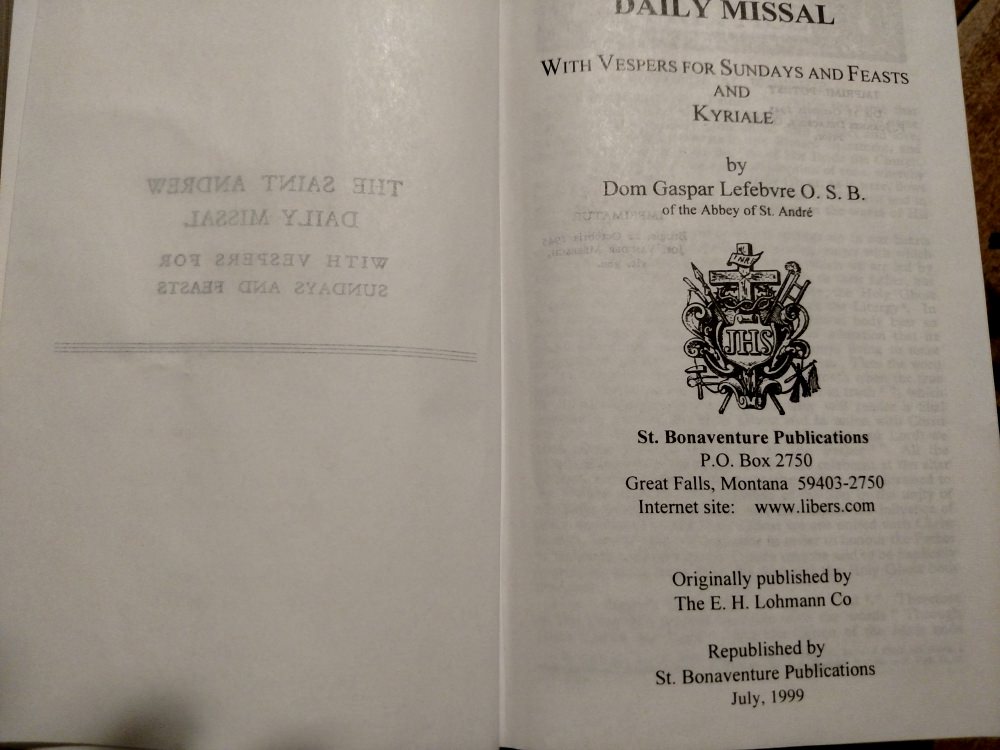 1945 Saint Andrew Daily Missal by St. Bonaventure Publications - title page.
1945 Saint Andrew Daily Missal by St. Bonaventure Publications - title page.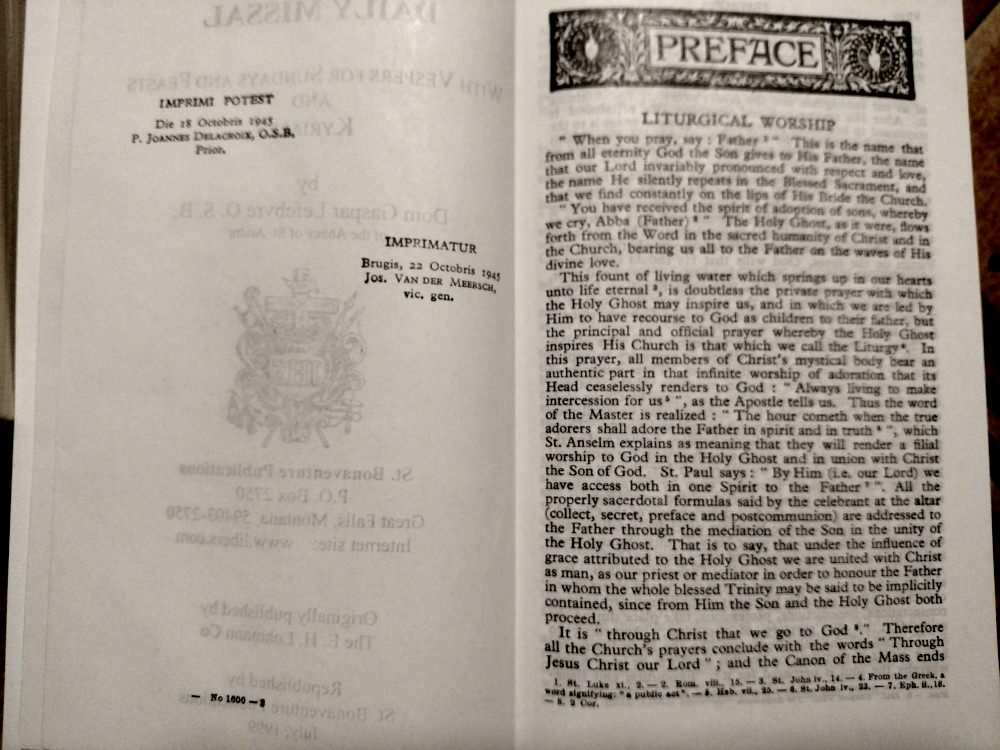 Saint Andrew Missal, St. Bonaventure Publications, imprimatur page.
Saint Andrew Missal, St. Bonaventure Publications, imprimatur page.The Saint Andrew Daily Missal from 1945 by Dom Gaspar Lefebvre, OSB, was a staple amongst traditional Catholics for many years until publishers began re-typesetting Missals in the 1990s.
You'll love their guarantee for the sake of certitude:
"Please note, when we reprint a book, the content of the book is unchanged, it is printed exactly as it was when originally printed. The only change we make is the first page, which contains our publishing information."
Do beware that there are at least two versions of the St. Andrew's Missal:
- As of 2019, the St. Bonaventure Catholic Missal uses the Douay-Rheims Bible in the readings, while
- Other versions use the paraphrased Confraternity for Christian Doctrine version of the Bible (CCD) which later morphed to be the New American Bible (NAB).
The Missal in the pictures above used the Douay translation, which is why it has been so well trusted. It has:
- Douay Epistles, Gospels, etc.
- Latin and English scriptures.
- Vespers and Kyriale in the back. (The first hand Missal to include the Kyriale because it was designed for religious to use.)
- Stories of the saints and feasts.
- Beautiful pictures for the larger feasts.
- Some of the dates are from the 1970 calendar.
- It has five colored bookmark ribbons and guilt edges.
You might prefer the newer Missals as there is a lot of page turning between Propers in this book as not all of the Epistles and Gospels are spelled out for each day. This is very confusing for younger children and can be noisy in church. Not to mention that some of the feasts are different.
The Saint Andrew Daily Missal is still in publication by St. Bonaventure Publications at Libers.com.
2.B. The New Marian Missal, 1947 (1953 Imprimatur)
Here's an oldie but goodie: The New Marian Missal For Daily Mass was first published in 1947 and bears a 1953 Imprimatur by Frances Cardinal Spellman. It is my personal favorite.
You might want to peruse the interior pages before you buy a Missal, so I have included pictures below. The first one is a photo of an actual old Catholic Missal (1953).
You can click on the small Missal images to go to a gallery of large photos.
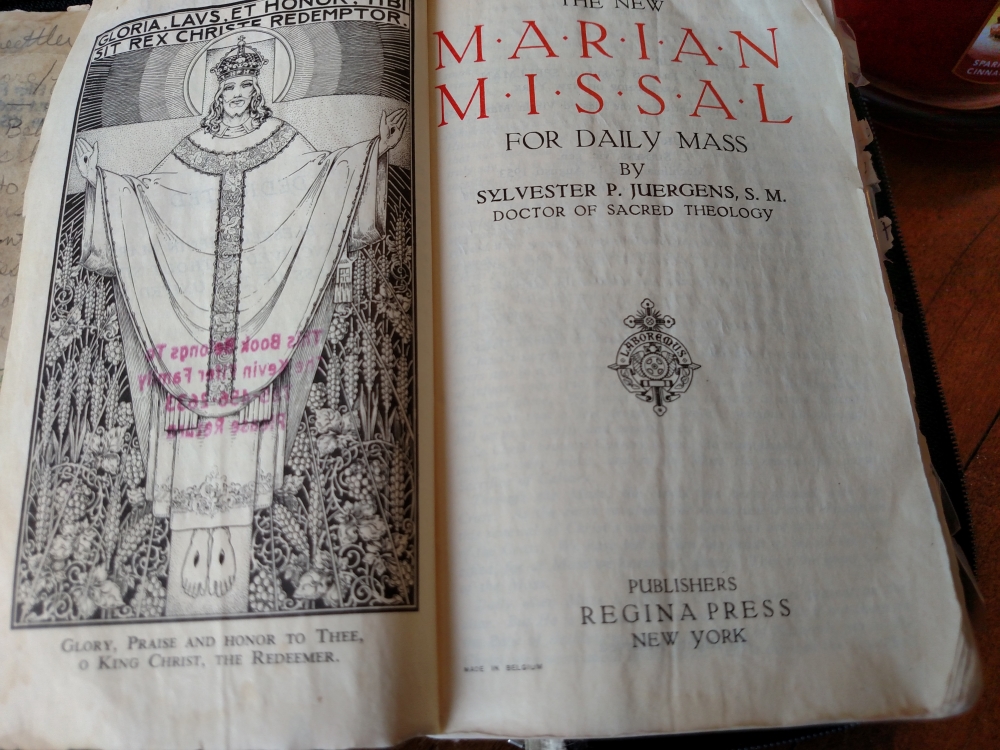 1947 New Marian Catholic Missal For Daily Mass, Juergens
1947 New Marian Catholic Missal For Daily Mass, Juergens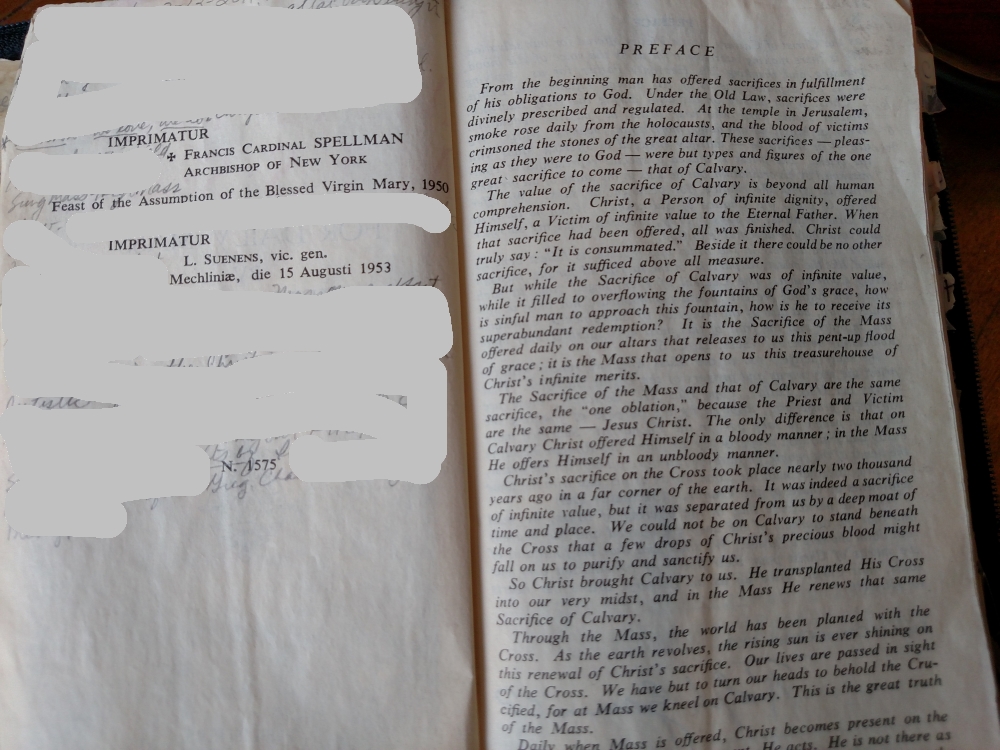 1947 New Marian Missal, Juergens; 1953 Imprimatur, Spellman
1947 New Marian Missal, Juergens; 1953 Imprimatur, Spellman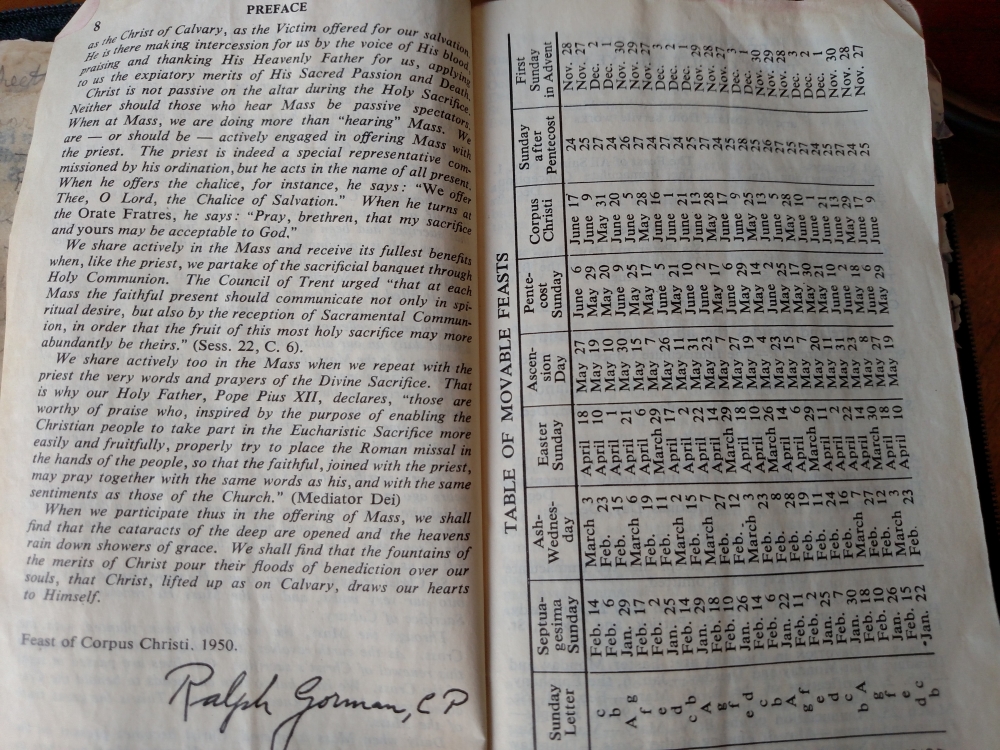 1947 The New Marian Missal For Daily Mass, Preface and Calendar of Feasts.
1947 The New Marian Missal For Daily Mass, Preface and Calendar of Feasts.3. Discerning A Good Catholic Missal
What is the difference between a Daily Missal and a Sunday Missal?
Catholic Sunday Missal
A Missal for children or a Sunday Missal will not have the daily propers of the saints.
This page does not discuss Catholic Sunday Missals.
Choose A Good Daily Missal
For adults I recommend the larger daily Missals as, even though you might only go to Mass on Sundays now, you might someday have the opportunity to go more often.
Retirement anyone? :-)
A daily Missal includes all of the Masses found in a Sunday Missal plus the Masses for the saints days and other feast days. Most of the daily Missals on this page have similar features.
On many days there are several choices for the daily readings (Proper of the Season or the Proper of the Saints - saints feast days) depending whether the day is in a season like
- Advent,
- Lent, or
- Paschal Tide;
- Or if the date falls on Sunday;
- Or whether two saints share the same feast day.
- Most days have their own Proper making the Missal the original daily meditation book.
Latin Mass Missals help you follow the Mass and they sometimes explain the Liturgy. They usually have the main Catholic prayers. You can also learn about the holy days and the feast days. Some even include short Lives of the Saints.
What's wonderful is that you can use these Missals year after year as the traditional Liturgical Calendar does not change much. Certainly no figuring whether you're on Year A, B, or C.
A Missal is also an excellent Confirmation gift for children who are old enough to have the responsibility of using such an important book, and for converts who are entering the Church as adults.
If you're comparing Missals, you can find the widest selection at Amazon including the 1945 Fr. Lasance New Roman Catholic Missal, The New Marian Daily Missal, and the 1962 Baronius and Angelus Missals. Each of them is a Daily Missal and has the info you would want in a Sunday Missal because it is a subset of the daily.
Finding the best Catholic Missal, a Daily Missal, Sunday Missal, or 1962 Missal, can be a real trick since most publishers or bookstores do not sell a variety of Missals.
They find a version they like, usually the best that they could find, and they print a reproduction of it.
Then they need to recoup their money. They cannot afford to print a variety of Missals. Also, they are convinced that the version they chose to print is the best.
Are you choosy?
As long as the publisher printed the prayers and readings intact, there are several easy litmus test questions to consider in selecting a Catholic Missal.
There is no way to catch all the revisions, omissions, and insertions - someone would have to fess up or two astute proof readers would have to compare the texts of thousands of pages, so consider these points:
- Does the Missal use the Douay-Rheims translation for the scripture readings? How does it "translate" Bible quotes like the Psalm 'Judica me' at the beginning of the Ordinary of the Mass?
- Also, how does it word prayers such as "Adoro te devote" by St. Thomas Aquinas on the feast of Corpus Christi?
- Another big "red flag waving" is the artwork. Is the art respectful? Or is it crude magic-marker art?
See more on these issues below.
3.A. Douay-Rheims Bible Readings VS. The Confraternity Version
The Vulgate by St. Jerome is still the only "official" Catholic Bible. The Douay-Rheims version is the closest version in English and it's been in use for centuries and was the only "version" till the 1930s and 40s.
There are many places where paraphrased Bible versions like the Confraternity version (Confraternity for Christian Doctrine, CCD) contradict or diminish the words' meanings from the readings in the Douay. Comparing Bible verses is a helpful test in finding a good Missal (or Lectionary for that matter).
- During Advent St. John the Baptist insists that we do penance. Protestant and other versions like the CCD use "Repent".
The Douay-Rheims Bible uses the word "man" in the classic manner meaning the universal "mankind" (which includes all those with an intellect or will: young or old, male or female, propertied or not, etc.).
- Many paraphrased versions use unisex words. The CCD was a leader in this in the 1940s.
The Catechism of the Bible says that the Latin variation of a word should be retained in the Bible rather than an Anglicization, for example:
- multitude should have been retained instead of changed to crowd (a diminution in meaning as well),
- testament instead of covenant (one need not die for a covenant),
- adore instead of worship where one can hear the Latin sounds like adore as Father reads it from the altar, etc.
- This applies to many more words that are changed in other versions.
As with all updated books and for having good readings and prayers, you can compare the Bible texts to the Douay Bible. This is a good indicator of whether a Latin/English Missal would be useful to you since paraphrases were already in use in the 1940s (CCD version, Msgr. Ronald Knox and other lesser known versions).
Note: The Baronius and Angelus are not reprints, they are new publications that added or "updated" some 1962 elements and the New Marian Missal.
I wonder if an actual 1962 Missal with the Douay translation was ever available. At least, these last few years I have begun to wonder if it was ever printed here in the USA.
I have heard that the few original 1962 Missals that had actually been in publication had been stopped at the presses or recalled in the 1960s in readiness for promoting Pope Paul VI’s Missal.
Each publisher may have had its own version or simply quit publishing the Missal. I would like to be able to source these ideas, yet have not been at liberty to do the research necessary.
The near yearly edition changes during the late 1950s are why there are so many books still existing, "used", or "pre-owned".
Perhaps you could ask your traditional Catholic priests, if they know which terms to use in a search for an honest musty-dusty Latin/English 1962 Missal.
If you learn of the the correct name or terms, I would be interested to learn what you were able to find.
3.B. Catholic Missal Prayers
Judica Me
The easiest Bible verse to find is the first prayer of the Mass. Check it to compare.
- Does the Judica Me ask "Judge me, O God, and distinguish my cause..."
- Or does it command "Do me justice..." (or worse)?
If one can prove there is no change in meaning in the second, one cannot prove that the demeanor of it is more humble. The better translation retains the Catholic disposition in a petition and offers a better reading experience through the year.
Keep these thoughts in mind as you search the Missal prayers to weigh which has the better version.
The Prayer before a Crucifix
Another Missal prayer to check is the The Prayer before a Crucifix. The Fr. Lasance Catholic Missal uses the better word contrition instead of repentance as found in some Missals.
Adoro Te Devote
The Adoro Te Devote by St. Thomas Aquinas as found on the Feast of Corpus Christi is another good place to look. Some versions use more sensual words in the prayers.
If the words of the prayers betray the sense of the Faith, beware the book.
This is one reason it is so important to learn the best Catholic answers to the catechism. We need to have a way to tell the good books from the bad and the catechism is the best place to start.
The catechism teaches the Apostle's Creed, the Sacraments, the Catholic Ten Commandments and the virtues. If the sense of a text concurs with these then you can have more certitude that the Missal teaches the Faith and prayers well.
3.C. Missal Artwork
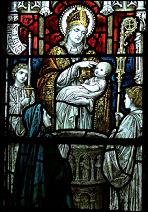 A Catholic Missal uses beautiful art.
A Catholic Missal uses beautiful art.Many times a book that is published by a well financed institutional publisher uses poor artwork. Be on your guard. This is a red flag waving.
Haggard or ugly faces, magic-marker art, or indecent and unusual presentations that distort the Catholic message in the picture, usually indicate a lack of discernment, or a deliberate misstatement about the Faith on the publisher's part. [I don't mean those publishers who are struggling to revive the Faith who in good faith did not know that there is a wealth of Catholic art now in the public domain.]
It is well known that there are publishers who have purposely published bad books, and often times bad artwork is a red flag waving to help you discern.
A new trick since the turn of this century is to restore some Catholic elements while removing others. This is exhausting. To wit: the old, the medium, and the new Confiteor - in English, of course.
4. What Makes A Catholic Missal Trustworthy?
A Catholic Missal uses:
- The Douay-Rheims Bible translation in the Propers and the Ordinary of the Mass
- The prayers retain a sense of humble sacrifice to the Blessed Trinity.
- Beautiful prayers are well worded.
- And it has beautiful artwork. This is easy to scan or flip through the book for a general impression.
Truth is the most important thing to consider. Truth first. Do the words themselves reflect the Word of God, or are they paraphrases?
Translations of prayers in a good Catholic Missal do have some room for legitimate variety, especially if the translator comes from a different country, for example: England, France, Germany or Spain.
You'll probably agree that there is no room for purposefully different "versions".
See my list of red-flag catechism sightings to see how "minor" revisions and omissions are not required by law to be marked or to have the copyright and publication information changed.
In this day of easy electronic manipulation one needs to be able to compare against the standard of Catholic principles: truth, beauty, modesty (in words as well as in images).
Buy A Traditional Catholic Missal - Check For The Douay Translation
Disclosure: I show products that I think will help you. If you use my links, I may earn ad commissions at no extra cost to you. As an Amazon Associate I earn from qualifying purchases.
As an Amazon Associate I earn from qualifying purchases.
1. Uses the 1958 calendar, virtually the same as the 1962 Catholic Missal.
2. 1945 calendar with additions. Wonderful pictures.
3. Uses some 1970 dates (Cabrini), maintains priest and sacrifice in rubrics.
4. Uses the 1962 dates, changed priest to celebrant and sacrifice to celebrate.
5. Latin Missal Video: Dr. Taylor Marshall
Here's an interesting overview of Dr. Marshall's reason for preferring a Fr. Lasance Latin Mass Missal to the FSSPX Angelus Missal for the TLM.
He acknowledges that the Lasance is not updated, but shows that it's not too hard to stay with the priest on most days. I heartily agree. I would say the same for the old New Marian Missals.
Traditional Latin Mass Missal Review: Which is the BEST? ~Dr. Taylor Marshall
6. Questions About The Catholic Missal
6.A. Why is there not a missalette in the pew at a TLM Mass?
The readings for the TLM are the same every year.
Nice.
There's no need to wonder whether this is Year A, B, or C.
The Missalette came to be necessary due to the many changes during Pope Paul VI's reign.
6.B. Would you guide me in selecting a 1962 Missal?
This is the hard part. Why? It is hard to choose between Catholic Missals if you cannot see them. Most book stores only have one or two that match their own publishing philosophies.
As above there are basically only two 1962 Missals in publication as of 2019. These are new books (Baronius and Angelus). The actual 1962 was not well sold in the USA even in the 1960s.
Any previous version has most of what the 1962 has since the Vatican was continuously eliminating prayers since at least 1948. Perhaps there is a true 1962 Missal from England?
Personally, I am very happy with my older New Marians, I simply read the extra prayers or skip them to stay on the same page as the priest.
So your choice is between the Angelus and the Baronius. Simple.
Well not so simple if you cannot see both of them at once or have no idea what to beware. Generally, either one is good, but there sure are quite a few differences.
And not so simple if you consider the Saint Edmund Campion Missal. It's huge! I would find it unwieldy.
Even though it has wonderful images and photos inside and would appeal to children because of the pictures, it is way too big for them to use at Mass. Adults might have a better time holding the book, but over time a hand Missal is a world easier to use. It also uses "through Him".
It is a Sunday Missal as it does not have the Proper of the Saints for daily Mass. It can't. Those wonderful pictures and hymns take up the space.
The best way to choose a 1962 Missal is to ask your priest which one to buy. :-)
6.C. Would you recommend the Newman Press ALTERATIONS AND ADDITIONS TO THE MISSAL?
This is interesting. I have not seen this edition of the Missal, "Newman Press ALTERATIONS AND ADDITIONS TO THE MISSAL", Westminster, Maryland (as seen at Ebay). Sure enough it says 1962 on the title page, and even "Ordained by the Holy See to come into force 1 January 1962".
This note might help settle the confusion of where the "real" 1962 was or when it was printed. It would have had to have been printed in 1959 to have come into force by the first day of 1961. Hm.... Good find.
This spanse of time does make sense, though, as, especially back then, it took much longer to print, publish, and promote a book than it does now.
It seems to me that the seller is not familiar with a Catholic Missal since the Imprimatur page is not shown with its credit to which version of the Bible it used, nor is the beginning of the Mass shown, nor a major feast day.
I am looking at the translation of the first two photos of text (fifth and sixth photos) and find that they must be from the new dates in the Liturgical Calendar of the time. This is to be expected according to the title. They're quite simply additions to the Missal as the title explains; so there is no way to compare what is in my older Missals for only the Collect.
The translations on the seventh photo showing pages 338 and 339 are not the same as the Douay and might even have a different meaning - check a Douay-Rheims Bible (DRB) online for the traditional Bible quotes from before the Confraternity of Christian Doctrine version (CCD revision). On p. 338 it appears that this Missal skips the Chrism Mass of Maundy Thursday moving directly from Wednesday in Holy Week to the Evening Mass on Maundy Thursday. The Epistle (I Cor. 11:20-32) on p. 339 also has a very different translation from the DRB.
Moving to the eighth photo, or page 222 of the Newman Missal, the Introit translation is, again, very different while the Latin is the same. The Epistle is also worded very differently.
The ninth photo of pages 1134 and 1135 shows similar translations as above. I have not found corresponding pages to the eleventh photo.
So, to answer your original question, "Is this one of the recommended versions?"
No. I would not recommend the Newman Missal to you because the Bible quotes are revisions or paraphrases.
Thank you for asking as I had not realized that the 1962 was in print by 1961.
6.D. Are the Angelus and Baronius Missals Original?
They were both "based" on The New Marian Missal, by Sylvester P. Juergens, S. M.
The Angelus Press version is an entirely new version with certain changes, even since 1962. The Angelus Press added the Latin Epistles and Gospels that earlier Juergens books did not have. It is the
The new Baronius reprint seems to be the most faithful version of the actual 1962 Missal, or more precisely of the previous Juergens Missal as it retained many of the same rubrical notes and the Catholic vocabulary: priest, sacrifice, etc.
If you need a 1962, specifically, compare the Baronius and the Angelus using the photos on this page above.
6.E. How did you find the differences in all these Missals?
Easy. We were looking for the best Missals for our children.
Well. Not so easy.
Back in the day there was no internet. Now, if you can spell it, you can find it online.
There have been Roman Missal changes ever since the first one was printed. The speed at which the changes came ramped up in the late 1940s. This is why there are so many "original" Missals from the 1950s.
What little I know of the many different Missals is the result of our parental duty of state with our children. When we first were buying our Missals, good versions were hard to find especially without the wonderful aid of the internet.
Then God was good to send us eight children. As the last children needed their Daily Missals in the early 2000s, Baronius Press in England and Angelus Press in the United States published their own versions of “the” 1962. They are different. We own one Baronius which is off to college with one child and one Angelus which is home here on a shelf.
If I personally wanted an actual "1962" I would probably search for a used Baronius, yet know ahead of time that it is not an “original” 1962 Missal but a 2004/2009 publication. (Oh! Will the "real" 1962 please stand?) Otherwise, I am very happy to navigate the older New Marian editions.
6.F. What is the main difference in the Ordinary of the Mass in the 1962 Missal and the other versions?
As for finding an intact and an actually original 1962 Misal that makes it easy to follow the Mass with all its parts?
I have not seen one online or in real life.
The main difference I have found in the Canon of the Mass is simply the phrase “et beati Joseph, ejusdem Virginis Sponsi”.
Further, I own at least two "St. Joseph Missals" that do not use the Douay Bible and have odd versions of the prayers.
6.G. Where is the original 1962 Missal?
As for searching today for an “original” 1962 Sunday Missal in Latin and English? Good luck. You might have to depend on the Editio Typica with a Roman Missal PDF.
From the photo of the Imprimatur page of the Baronius on our website, I see that it is “based upon the Daily Missal and Liturgical Manual (16th edition) published by Laverty & Sons, Leeds, in 1960 and has been fully revised and updated….”
So if you're searching, you could add variations of these terms (Daily Missal and Liturgical Manual (16th edition) published by Laverty & Sons, Leeds); Editio Typica of The Roman Missal and Breviary 1962; or The New Marian Missal, by Sylvester P. Juergens, S. M. to narrow your search.
By the 1960s not only were multiple Bible translations being used, the prayers and even the Ordinary of the Mass prayers were being changed.
I do not know if the Fr. Lasance New Roman Missal or the St. Andrew Missals were “updated” to a 1962 edition before the 1980s and 1990s' reprints of the older 1940s editions. You could search those terms adding 1962.
7. Comments From Visitors
7.A. Baronius And Angelus Kyriale Comparison
I sell both the Baronius Press and the Angelus Press missals. To me personally because I was trained to sing the Kyriale, I can't use the Baronius Press' Kyriale, but I could the Angelus Press' Kyriale because the Baronius Press' Kyriale does not contain any dot at all which is required to double the length of notes. So I have stopped selling the Baronius Press' missal.
Writing from the FSSP chaplaincy based in Auckland, New Zealand. ~ Francis Y.
Note: Old Missals did not have the Kyriale in them as it was late that lay persons began to sing the chants with the religious choir or in place of the choir. Both the Angelus version and the Baronius added elements to their books to meet the new demands.
You are welcomed to use my feedback any way you see fit, ma'am. The Baronius Press missal is so very beautifully crafted but its kyriale is a huge let down for me. I just can't use its kyriale, fullstop; I have resorted to chanting the kyriale by using the Square Notes mobile app on my phone. So, I need to carry my Baronius Press missal and my phone to Mass.
By the way, something else: The Angelus Press missal has rather detailed and very useful information accompanying the ordinary of the Mass. Information which is not available anywhere else that is easily found by the layperson. I know of a Novus Ordo coordinator for his parish's RCIA and he found the answers to his questions in the Angelus Press which the Baronius does not even have. Information that folks hunger for can be found in the Angelus Press missal. I am not biased towards the SSPX as I attend the FSSP's. I only attend SSPX's once a month when more convenient. Here in West Auckland, we have FSSP, SSPX and diocesan TLMs. Thanks be to God.
God bless and keep up with the good work.
Francis Y.
Related Catholic Missal Resources
Keep true Catholic principles in mind when you're searching for a Catholic Missal.
Then say a prayer to Saint Anthony. :-)
You might also like these pages:
Thank you for visiting Saint Anne's Helper!
~Mary
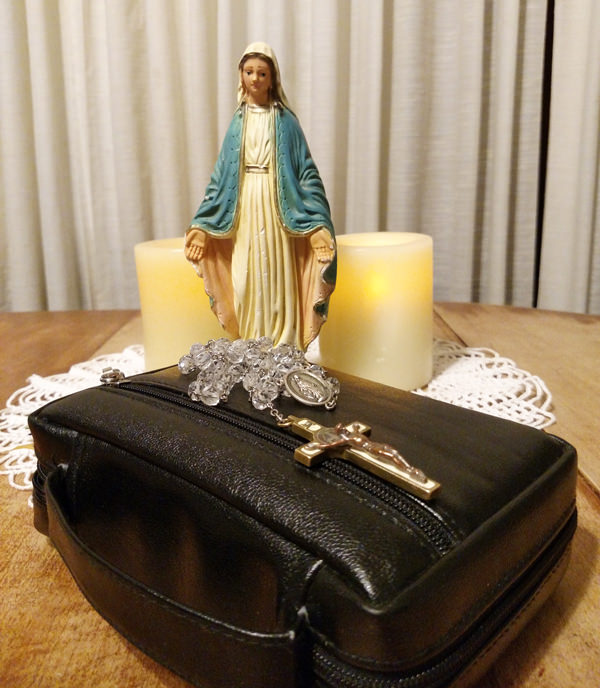 It's easier to follow the Mass with a Catholic Missal.
It's easier to follow the Mass with a Catholic Missal.





